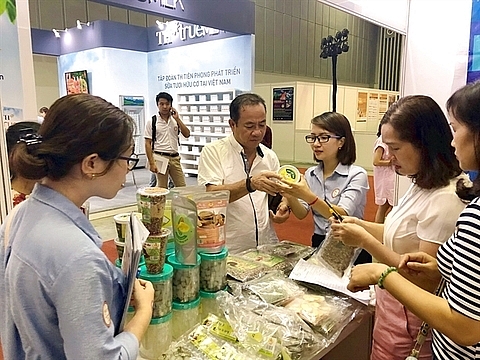Farm produce processing industry urged to tap potential
 |
| Vietnam’s agro-forestry and fishery processing industry has bright prospects in both export and domestic markets, but needs further measures to tap its potential, according to the Agro Processing and Market Development Authority. - VNS Photo |
Speaking at a conference in HCM City on Wednesday, Nguyen Quoc Toan, the authority's director, said: “The domestic agro-forestry and fishery processing industry had an annual growth rate of 5-7 per cent over the past 10 years, creating a system with total processing capacity of about 120 million tonnes of farm produce materials a year."
The country is home to over 7,500 enterprises involved in agro, forestry and fishery processing on an industrial scale for export, besides tens of thousands of small-scale processing facilities serving the domestic market.
“The processing industry has significantly increased the value of Vietnamese agricultural products, contributing to building a modern agricultural system,” Toan said.
However, the industry's development has not been commensurate with its potential, he said. Shortcomings and bottlenecks in its value chain include the low level of processing technology, lack of diversity of processed products, and weak linkages among stakeholders in material supply, processing and consumption.
Dr. Le Manh Hung, representative of the Sub-Institute of Agricultural Engineering and Post-Harvest Technology in the South, said that fruit and vegetable exports increased strongly from US$151.5 million in 2003 to $3.8 billion last year.
“Exports are expected to continue to rise since Vietnamese exporters have increased shipments to high-grade markets such as the US, EU, Japan, South Korea, Australia and New Zealand.”
However, Viet Nam's agricultural products in general are less competitive than those from more developed countries in the region and the world because of higher prices, he said.
He attributed the situation to a lack of post-harvest and processing technologies.
According to experts, free trade agreements have opened up opportunities for domestic food firms to enhance exports.
But to capitalise on the opportunities, local firms need to invest more in deep processing to add more value to their products.
Hung said: "To improve added value, besides researching and applying high-tech technologies to preserve fresh fruits and vegetables, it is necessary to focus on investing in processing technology for frozen vegetables and fruits, and fresh-cut fruits and vegetables.”
Nguyen Dinh Tung, general director of Vina T&T Group, which exports many products to the US, said that processing demands could not be met by domestic material supply, which remains the main obstacle for the agricultural processing industry.
Viet Nam needs to create a zoning plan for large scale high-quality material areas to meet quality, hygiene and food-safety standards in the global food supply chain, he said.
The country targets $65-70 billion from agro-forestry and fishery exports by 2030, double the current figure, with its processing technologies meeting an average level or above, and some commodities having processing technologies at the highest level in the region.
To realise the targets and to bring more Vietnamese agricultural products to developed markets, in addition to enhanced cooperation among industry stakeholders, the sector needs support from the Government, delegates at the conference said.
The international conference on “Development of the processing and preserving industry for agricultural products in the integration period” was held on the sidelines of the Viet Nam International Exhibition on Processing, Packaging and Preserving Food and Agricultural Products in HCM City from July 24 to 27.
What the stars mean:
★ Poor ★ ★ Promising ★★★ Good ★★★★ Very good ★★★★★ Exceptional
Related Contents
Latest News
More News
- Businesses ramp up production as year-end orders surge (December 30, 2025 | 10:05)
- Vietjet chairwoman awarded Labour Hero title (December 29, 2025 | 13:06)
- How to unlock ESG value through green innovation (December 29, 2025 | 10:03)
- AI reshapes media and advertising industry (December 29, 2025 | 08:33)
- FPT and GELEX sign deal to develop blockchain tech for global markets (December 29, 2025 | 08:29)
- Vietnam’s GDP forecast to grow by 9 per cent in 2026 (December 29, 2025 | 08:29)
- Women entrepreneurs are key to Vietnam’s economic growth (December 29, 2025 | 08:00)
- Vietnam's top 500 value-creating enterprises announced (December 27, 2025 | 08:00)
- The PAN Group shaping a better future with ESG strategy (December 26, 2025 | 09:00)
- Masan Consumer officially lists on HSX, marking the next phase of value creation (December 25, 2025 | 13:20)

 Tag:
Tag:

















 Mobile Version
Mobile Version